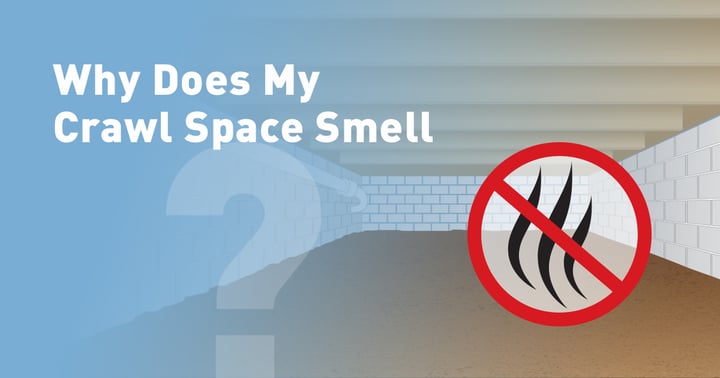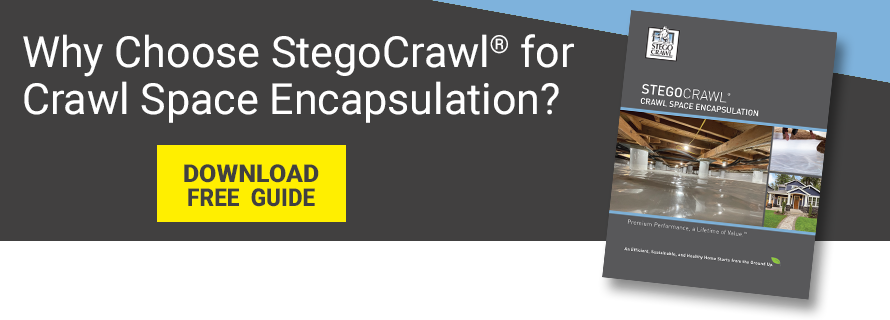Why Does My Crawl Space Smell? Troubleshooting the Source of Odor

I get a fair amount of calls from homeowners with various descriptions of crawl space odors. One homeowner was complaining about an odor coming from his crawlspace, so I was able to refer them to a local contractor who I’d had experience with in the past. The contractor headed over to the home and reported finding an old rusty drum of oil stowed away in the crawl space. The home was old and no one knew how long it had been down there, but thanks to moisture in the crawl space, the barrel had finally rusted through. The odor of exposed oil was being drawn into the home via stack/chimney effect.
We got lucky that one was so easy. Other times, the culprit may not be so obvious. Read along for some troubleshooting steps to see if you can identify any odor issues you may be having. I’ve tried to list these from easiest to identify, to more difficult.
Foreign Objects
Do you see anything in your crawl space that probably shouldn’t be there? Any paint cans? Trash left behind from the builders (Mountain Dew™ cans seem to be common)? Items left from the previous owner? It’s okay to store items in your crawl space, but you’ll want to make sure the crawl space is sealed, clean, and odor free before you start piling items into that relatively stagnant area of the home.
Rodents or Rodent Droppings
Technically, this could classify as “foreign objects” (see above), but it is so common it is worth standing alone in this article. In one, partial crawl home near a cornfield I found 17 dead mice (and unfortunately probably just as many that were still alive). Make sure your crawl is clear of decaying carcasses and rodent fecal matter. Both will stink up your home!
Mold
Mold is only possible due to moisture, and can clue you in to underlying moisture problems in your crawl space. While not all molds produce a smell, they can cause wooden structures (like floor joists), or other organic materials to decay, creating a nasty mildew odor. Also, if you store boxes or other things in your crawl space, it’s a good idea to inspect those items for mold, especially if the air feels humid or damp. If you do spot mold, it’s important to understand the potential health risk. Mold releases mycotoxins, which are harmful to your respiratory system and that’s why, if you identify mold, you should contact a contractor and take steps to remove all signs of it immediately.
Moisture and High Humidity
Like mold, humidity is also due to the presence of moisture. High humidity is a common problem in unsealed crawl spaces, but it can also show up in spaces with a sealed floor or concrete slab. While a smooth concrete surface may give the appearance of a clean, dry space, it’s never safe to assume. Here’s why:
When concrete slabs are poured, moisture gets trapped beneath the slab as it dries. Eventually, this water vapor will make its way back up through the concrete slab and enter your crawl space due to a difference in pressure. Bacteria can form in the areas where the vapor collects and emit an odor. Likewise, if the vapor has anything to latch onto (fiberglass insulation, for example), mold can take root and create bad smells.
The Soil Beneath Your Home
If you’ve got a crawl space with unsealed floors and exposed dirt, the dirt may be the source of the bad smell. Soils are naturally full of small organic materials, and as these materials decompose over time, this natural process of decay inevitably emits odors or even odorless radon gas, which can be dangerous. What’s more, moisture within the soil is bound to permeate upwards, causing the crawl space to become wet and damp. Water and moisture increase the decay of organic materials and therefore, the problem will persist. In extreme cases, where the soil beneath a crawl space is actually backfill brought from another location—say, a farm or other rural area—the soil could contain manure or compost, both of which will emit bad odors that will ultimately rise up into the rest of your house.
The Products Used to “Fix” Your Crawl Space
Not all culprits are of organic composition, either. Another possible cause of bad crawl space smells? Products that have chemicals that off-gas into the crawl space area. I’ve listed this one last because it is difficult to detect and is a complicated topic deserving its own post. Look for a future blog post from me about the types of off-gassing that may be possible from some common products and I’ll also dive into that all too common cat urine odor that has everyone in this industry so frustrated.
Identifying Smells and Risks in Your Crawl Space
If you own or rent a home with a crawl space, carefully monitor the conditions inside, especially if you start to detect strange smells in your house. Whether you enlist the help of a contractor or inspector or take a look yourself, it’s important to properly identify the cause of the odor and to keep in mind any possible health risks. Being vigilant will help to keep your house smelling fresh and clean, and also protect your family from potential harm.
While crawl space smells may be a nuisance for homeowners, there are safe vapor barrier products available to prevent these problematic odors. Vapor barriers are not only effective in preventing these smells from developing, but also in keeping the space protected from moisture, soil gases, and mold. If mildew and smells are plaguing your crawl space, ask your contractor about a high-quality vapor barrier, and take the first step toward creating a dry, odor-free crawl space.

Written by Tom Marks
Tom Marks is the Business Development Project Manager with Stego Industries, LLC. He has been with Stego since 2007, serving many years as the Rocky Mountains Regional Manager. Now, his focus is geared toward vapor barrier solutions for new and existing homes as the Product Manager of the StegoHome and StegoCrawl brands. In addition, Tom serves as Sustainability Manager, overseeing Stego’s leadership in holistic product and corporate sustainability. Tom enjoys working with a wide range of project team members and customers to incorporate effective sub-slab vapor protection and create healthy, sustainable homes and buildings.
- Stego (26)
- StegoCrawl (24)
- Stego-Awareness (17)
- StegoHome (15)
- Case Studies (14)
- StegoCrawl-Consideration (12)
- StegoCrawl-Awareness (11)
- Customer Stories (9)
- Stego-Consideration (9)
- Pango (8)
- StegoHome-Consideration (8)
- Beast (7)
- How to Install (7)
- StegoHome-Awareness (7)
- Drago (5)
- Pango-Awareness (5)
- Beast-Awareness (4)
- Beast-Consideration (3)
- Drago-Awareness (3)
- Pango-Consideration (3)
- Stego IQ (3)
- Drago-Consideration (2)
- StegoCrawl-Decision (2)
Popular Posts
Stay Connected.
Enter your email below.







Post Comments